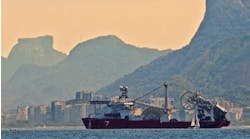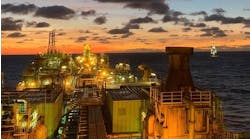V.P. ShcherbakovRussia is one of the world's largest producers of oil and gas, but is now producing just over a quarter of its production level during the most favorable years for the oil industry of the USSR.
The Russian Federation Committee on Geology and Use of Mineral Resources.
The transition to a market economy for the oil and gas industry is very difficult but results of this process are obvious. Recently, ten large vertically integrated oil companies were organized, and since then, their role in the regulation of exploration and the production process has increased, in addition to their parts in the refining and sale of oil products on both the domestic and overseas markets. There are, in addition, about 40 joint ventures connected with oil production.
Although Russia has huge proven and explored onshore petroleum reserves, especially in Western and Eastern Siberia, the future development of the Russian petroleum industry will be connected with offshore hydrocarbon resources.
The continental shelf territory of the Russian Federation comprises about 4 million. sq. km, 90% of which is prospective for commercial petroleum accumulations. About 2 million. sq. km occur in the Barents and Kara Seas, or the Western Arctic Regions. In the Eastern Arctic Regions, the Laptev, East Siberian, and Chukchi Seas offshore areas are equal to another million. sq. km, and about 0,8 million. sq. km occurs in the Asov, Black, and Caspian Seas. A very small offshore site is known in the Baltic Sea.
The total potential hydrocarbon resources of the entire Russian shelf exceed 100 billion tons of oil equivalent, with gas resources predominating. Up to 70% of total offshore gas resources occur in the Western Arctic Regions, about 10% of them are known in the Far East seas, especially in the neighboring offshore of the Sakhalin Island. Oil resources are concentrated in the Barents, Pechora, Kara, East Siberian, and Okhotsk offshore areas.
Analysis of current information indicates that in some offshore areas the hydrocarbon resources may be essentially increased. There appears to be regions of the East Siberian and Chukchi Seas where prognostic increase of oil resources may be estimated at two to four times more.
Geological-geophysical information on the Russian offshore zones is insufficient. In early 1996, about 740 thousand km of 2D seismic profiles were carried out, but 3D seismic profiles have been done near the Sakhalin Island only. Information on the Azov Sea bottom as well as the northeastern offshore areas off Sakhalin is insufficient as well.
A total of 110 deep wells have been drilled throughout the Russian aquatory, including 66 wells around Sakhalin and 35 wells in the Western Arctic Regions. There has been no exploratory drilling anywhere else in the rest vast aquatory from the Kara Sea to the Magadan. Nevertheless, current data allow definition of the main geological features throughout the offshore territories, and it reveals the main structures and a geological history of these zones as well as singles out petroleum areas and regions. As a result, about 40 oil and gas basins have been identified, with hydrocarbon accumulations proven in 12 of them.
More than 400 local structures, have also been revealed, 84 of them with prospective hydrocarbon areas of up to 25 thousand sq. km, ready for deep exploration drilling. Until recently, it was allowed to selectively explore the reserves in the Barents, Kara, and Okhotsk Seas.
The efficiency of the offshore geological survey is exceptionally high, especially in the Western Arctic Regions, where the increase of resources per well reaches 1.5-2 million tons in oil equivalent. But at the same time, the development of Russia's offshore petroleum resources is practically at a standstill.
The most important results of the last years appear to be the revealing of the vast petroleum province throughout the Barents - Kara Seas, their total potential resources being estimated at 70 billion tons of hydrocarbon in oil equivalent, as well as large oil-gas-condensate fields northeast of Sakhalin Island.
The largest petroleum fields have been discovered within the Barents-Kara providence. They are as follows:
- Shtockmanskoye gas-condensate field in the Jurassic deposits of the south Barents Sea, with gas reserves of 3 trillion cubic meters.
- Leningradskoye and Rusakovskoye gas-condensate fields in Cretaceous deposits of the South-Kara region, with reserves estimated at 4-6 trillion cubic meters each.
- Prirazlomnoye Field in Permian deposits of the Pechora Sea.
- Several large fields were explored northeast of Sakhalin, such as the Piltun-Asokhskoye, Arkutun-Dagainskoye, Odotinskoye, and others. Agreements on exploration have been already signed with foreign investors.
Reconstruction of the Russian economy and reduction of state support for the petroleum industry have resulted in past state subsidies for geological surveys and exploration works being effectively withdrawn. Today, such works appear to have financial the support of business ventures and private capital, including foreign investors. Thus, there have already been rounds of license negotiations on Sakhalin-1, 2, 3; there have been signed agreements on Sakhalin-3. The round of license negotiations on Sakhalin-4 in 1995 was unsuccessful because the single participant, Exxon, had proposed unacceptable terms. Unfortunately, agreements on Sakhalin 1-1, Sakhalin-2, have been signed but not fulfilled by the foreign participants - Mobil, Marathon, Mitsui, Mitsubishi, McDermott, Exxon, and Shell - due to incompleteness of the Russian laws.
By the President's Decree, the exclusive rights on the exploitation of the gigantic Shtockmanovskoye gas-condensate field and the large Prirazlomnoye oil field were granted to the joint-stock society ROSSHELF, a subsidiary of the Russian joint-stock company GASPROM, created by several Russian enterprises, including the Ministry of Defense organizations in Severodvinsk. ROSSHELF has completed exploration drilling and carried out feasibility studies of two projects. From 1994, ROSSHELF's partner in development of the Prirazlonoye field appears to be BHP.
JS Company ROSSHELF and Arkticmorneftegasrzvedka granted licenses on geologic exploration and pilot exploitation of some of the projects in the Pechora Sea (North and South Dolginskoye Fields and others). And ROSSHELF and GASPROM are financing some seismic surveys which are being carried out by Sevmorneftegrofizika Trust.
In 1996, the first round of license negotiations concerning several sites in the Barents Sea is planned, the latter in accordance with the conception on exploration and development of petroleum resources of the Barents Sea province approved by the Russian Government, the analogous conceptions on study and development of the Far East and the Northeast offshore of Russia were prepared.
The petroleum potential of the Far East offshore, with predicted resources amounting to 20 billion tons oil equivalent, appears to be that it should also serve as the base to supply future needs of the vast Far East region and thus an important factor is its economic development. The primary task is the creation of an oil and gas industry with production up to 23 million tons a year of oil from northeast Sakhalin offshore areas. The second task includes exploration and development of the North Priokhotye and Western Kamchatka offshore potential. And, finally, estimation works in the Anadyr and Khatyr offshore areas must be carried out. Regional exploration and estimation of hydrocarbon resources are to be continued at the Chukchi and East Siberian Seas. The minimum of geological surveys, parametric and estimation drilling is provided in the Conceptions which is necessary for reserves increase at new offshore areas.
The main principles of the new strategy connected with offshore resource development are as follows:
- Attracting non-state markets, including foreign markets.
- State support for Russian companies and enterprises.
- Business interests of Russian onshore subjects are to be ensured.
- Establishment of priorities for sites proposed for the competitions depending on informational data, possible economic efficiency of a project realization.
- Prohibition of environmental and wildlife damage.
According to all information, sites will be proposed and competition rounds will be established for the period 1998-2002.
In late 1995, the Law on the Continental Shelf of the Russian Federation was implemented. It established the main positions of regulatory policy on development of petroleum offshore resources. There are the following items:
The Russian Law on Production-Sharing Agreements, implemented in early 1996, in detail established legal relations connected with investments into exploration and production of mineral resources based on production-sharing agreements. It is worth noting that the same clauses of the Law were subjected to criticism from foreign investors. This time, according to the Russian Government Resolutions, the preparation of several normative acts to enforce the Law into action is begun. These norms are as follows:
Besides, the work on preparation of supplementary items and modifications for current legislative acts based on the Russian Law on Production-Sharing Agreements is already begun. These items include:
- Law on Use of Mineral Resources.
- Law on Continental Shelf.
- Law on Foreign Investments.
- Tax Legislative Acts.
Apparently, it is necessary to introduce more precise definitions into some articles as well as into the Law on Production-Sharing Agreements itself.
Exploring and development of offshore petroleum resources based on the market economics in Russia are continuing, though with low effectiveness. We consider, however, that these offshore resources appear to be the significant base for future development of Russia.
Copyright 1996 Offshore. All Rights Reserved.


